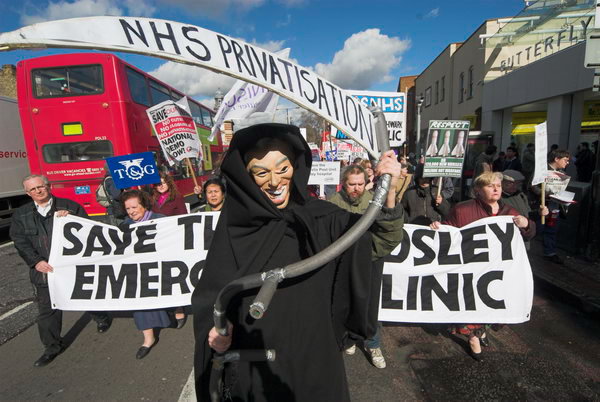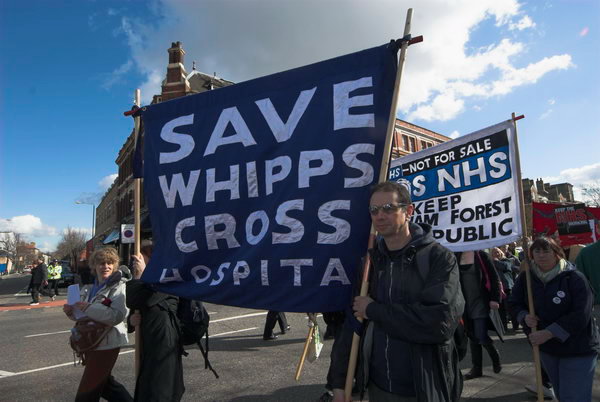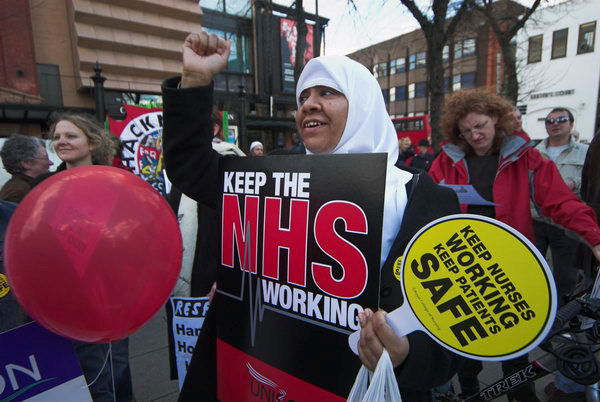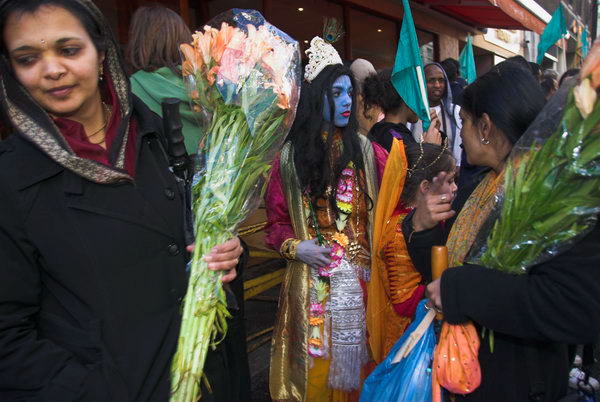Keep our NHS Public: Saturday 3rd March 2007 saw protests around the country against the increasing privatisation of the National Health Service and I managed to cover several of these events in London, a march in Camberwell followed by a march from Whitechapel to Hackney Town Hall where they joined others who had marched in Hackney. After finishing my coverage of these events I photographed the Hare Krishna in Soho and then went to the Photographers Gallery.

Here I’ll publish what I wrote back then on My London Diary with the usual corrections to spelling and capitalisation. Reading what I wrote below again now I think I was far too generous to New Labour. Although some MPs may have been well-intentioned I think the policies were largely driven by those with personal financial interests in private healthcare and other sectors that would profit from them. The NHS (and us) are still suffering from their actions and I have little confidence in the changes the current Labour government is now making.
Keep our NHS Public – Saturday 3rd March 2007

Although health workers and other trade unionists had called for a national demonstration in London, the union bosses declined to organise one, perhaps not wanting to embarrass an already beleaguered Labour government. What took place instead was a whole series of local demonstrations – including at least 7 in the Greater London area – across the whole country.

The overall effect was perhaps to make it more impressive, and certainly it seemed to get more coverage in the media that might otherwise have been expected, although there were few reporters and no TV crews at the three events I photographed (for some reason they preferred Sheffield.)

Largely well-intentioned attempts to improve the health service have failed to deliver as they should, with many services being cut. Part of this has been caused by a dogmatic insistence on making use of private finance with results that range from fiasco to farce, inevitably accompanied by long-term financial loss.

A second disastrous dogma has led to bringing in private enterprise to do the simple work at artificially inflated prices (they even get paid for work they are not doing) which has the secondary result of making the NHS services appear more expensive, as they are left to deal with the trickier cases.

Further blows to our national health service have been through the predictably disastrous IT projects; as well as going millions over budget, these have largely failed to deliver. Add the proliferation of management and expensive consultants, along with crazed assumptions in negotiating doctors’ pay leading to an unbelievably generous offer, and it it hardly surprising that the whole system is in financial chaos.

The government clearly lacks a real commitment to the kind of National Health Service many of us grew up with, run for the benefit of the people rather than to make money for healthcare corporations. The health service certainly needed a shake-up to reduce bureaucracy and eliminate wasteful practices, but instead new layers of both have and are being added.

I started off in Camberwell, and had time for a short walk before the speeches and march began. It wasn’t a huge event, but there was strong support from those in the service, from patients and from pensioners, as well as local MP Kate Hooey. From Camberwell Green the march went down to the Maudsley Hosptial where a letter was handed in and I got on a bus and left for Bethnal Green and Hackney.

Going up the Cambridge Heath Road in the centre of Bethnal Green, I saw the march from the Royal London Hospital in Whitechapel to Hackney in the distance. Unfortunately the bus was held up in the traffic behind it, taking almost five minutes to reach the next stop before the driver would open the doors and let me off. Some things were a lot easier with the Routemasters.

This was a smaller march than that from Camberwell, and after a few minutes I felt I’d photographed all I could, so I ran ahead and caught a bus for the centre of Hackney, arriving there just a couple of minutes before the Hackney march, which had come from Homerton Hospital, had returned to the town hall. I photographed them arriving and then the rally that ensued.

The Hackney march was a little larger, perhaps around two hundred, and there were quite a few speakers, including local councillors and representatives from the various organisations that had helped to organise the march.

A big cheer went up as the march from Whitechapel arrived, swelling the numbers in the square at the town hall.

Among the better known speakers taking part were George Galloway, whose speech lived up to his usual high standards of wit and common sense. Lindsay German, a hackney resident well known for her work for ‘Stop The War’ also spoke with feeling on the issues of health and the NHS. Several of the other speakers were old enough to have known the problems before the health service was set up.

As the meeting began to wind down, I caught a bus to Bethnal Green and then the tube to Tottenham Court Road. Just to the north of Soho Square I got to the Hare Krishna Temple just as the annual Gaura Purnima [Golden Full Moon] procession was arriving back from its tour around the area.

From there I went to the Photographers’ Gallery to have a good look at this year’s photography prize contestants. I hope the prize goes to one of the two photographers on the shortlist, Philippe Chance or Anders Petersen. [Neither won.] Walking through Soho and Westminster I took a few more pictures.
More pictures on My London Diary.
Flickr – Facebook – My London Diary – Hull Photos – Lea Valley – Paris
London’s Industrial Heritage – London Photos
All photographs on this page are copyright © Peter Marshall.
Contact me to buy prints or licence to reproduce.







